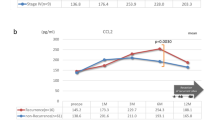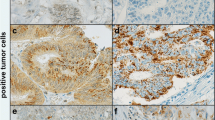Abstract
Background
Molecular metastases are precursors of postoperative recurrence, detected by molecular-biological tools. Chemokines and their receptors contribute to dissemination and local immune recognition. A strong expression of the chemokine receptor CCR5 is associated with non-metastatic colorectal cancer and increased CD8+ T-cell infiltration. The aim of this study was to analyze whether CCR5 expression correlates with the presence of hepatic molecular metastases (MM).
Methods
Ninety-three patients undergoing elective surgery for colorectal cancer were assessed. The K-ras mutation status was defined by PCR–RFLP, and the CCR5 expression status was analyzed by CCR5-specific reverse transcription (RT-PCR) analysis. Liver biopsy samples had been intra-operatively taken to screen for MM. MM were detected by K-ras-specific PCR–RFLP and nested CK20/GCC RT-PCR. Prevalence of MM was correlated with CCR5 expression status.
Results
Human colorectal cancer harboured K-ras mutations in 53% (codon 12: 47%; codon 13: 6%) of cases. Among K-ras mutants, MM were detected in 27–53% of patients, dependent on the technique applied (K-ras-specific PCR–RFLP assay vs. nested CK20/GCC RT-PCR approach (P = 0.004)). CCR5 expression of K-ras mutants ranged from absent (23/49: 47%), weak (17/49: 35%), intermediate (4/49: 8%) to strong (5/49: 10%). MM were found in 30% of CCR5 negative and in 23% of CCR5 positive cancer patients by the K-ras-specific PCR–RFLP assay. The nested CK20/GCC RT-PCR assay detected MM in 87% of CCR5 negative and in 27% of CCR5 positive colorectal cancer patients (P = 0.00002).
Conclusion
Thus, CCR5 expression of the primary cancer might be a valuable biomarker indicating the absence of hepatic molecular metastases.

Similar content being viewed by others
References
Arya M, Patel HR (2003) Expanding role of chemokines and their receptors in cancer. Expert Rev Anticancer Ther 3:749–752
August DA, Ottow RT, Sugarbaker PH (1984) Clinical perspective of human colorectal cancer metastasis. Cancer Metastasis Rev 3:303–324
Balkwill F, Mantovani A (2001) Inflammation and cancer: back to Virchow? Lancet 357:539–545
Bosch B, Guller U, Schnider A, Maurer R, Harder F, Metzger U, Marti WR (2003) Perioperative detection of disseminated tumour cells is an independent prognostic factor in patients with colorectal cancer. Br J Surg 90:882–888
Brigati C, Noonan DM, Albini A, Benelli R (2002) Tumors and inflammatory infiltrates: friends or foes? Clin Exp Metastasis 19:247–258
Charo IF, Ransohoff RM (2006) The many roles of chemokines and chemokine receptors in inflammation. N Engl J Med 354:610–621
Chiba T, Ohtani H, Mizoi T, Naito Y, Sato E, Nagura H, Ohuchi A, Ohuchi K, Shiiba K, Kurokawa Y, Satomi S (2004) Intraepithelial CD8+ T-cell-count becomes a prognostic factor after a longer follow-up period in human colorectal carcinoma: possible association with suppression of micrometastasis. Br J Cancer 91:1711–1717
Conzelmann M, Dieterle CP, Linnemann U, Berger MR (2003) Cytokeratin 20 and guanylyl cyclase C mRNA is largely present in lymph node and liver specimens of colorectal cancer patients. Int J Cancer 107:617–628
Conzelmann M, Linnemann U, Berger MR (2005) Detection of disseminated tumour cells in the liver of cancer patients. Eur J Surg Oncol 31:977–985
de Jong MC, Pulitano C, Ribero D, Strub J, Mentha G, Schulick RD, Choti MA, Aldrighetti L, Capussotti L, Pawlik TM (2009) Rates and patterns of recurrence following curative intent surgery for colorectal liver metastasis: an international multi-institutional analysis of 1669 patients. Ann Surg 250:440–448
Denkert C, Loibl S, Noske A, Roller M, Muller BM, Komor M, Budczies J, Darb-Esfahani S, Kronenwett R, Hanusch C, von Torne C, Weichert W, Engels K, Solbach C, Schrader I, Dietel M, von Minckwitz G (2010) Tumor-associated lymphocytes as an independent predictor of response to neoadjuvant chemotherapy in breast cancer. J Clin Oncol 28:105–113
Greenlee RT, Murray T, Bolden S, Wingo PA (2000) Cancer statistics, 2000. CA Cancer J Clin 50:7–33
Iida N, Nakamoto Y, Baba T, Kakinoki K, Li YY, Wu Y, Matsushima K, Kaneko S, Mukaida N (2008) Tumor cell apoptosis induces tumor-specific immunity in a CC chemokine receptor 1- and 5-dependent manner in mice. J Leukoc Biol 84:1001–1010
Jass JR, Love SB, Northover JM (1987) A new prognostic classification of rectal cancer. Lancet 1:1303–1306
Keene SA, Demeure MJ (2001) The clinical significance of micrometastases and molecular metastases. Surgery 129:1–5
Kienle P, Koch M, Autschbach F, Benner A, Treiber M, Wannenmacher M, von Knebel Doeberitz M, Buchler M, Herfarth C and Weitz J (2003) Decreased detection rate of disseminated tumor cells of rectal cancer patients after preoperative chemoradiation: a first step towards a molecular surrogate marker for neoadjuvant treatment in colorectal cancer. Ann Surg 238:324–330. (discussion 330–331)
Kondo T, Nakazawa H, Ito F, Hashimoto Y, Osaka Y, Futatsuyama K, Toma H, Tanabe K (2006) Favorable prognosis of renal cell carcinoma with increased expression of chemokines associated with a Th1-type immune response. Cancer Sci 97:780–786
Le Y, Zhou Y, Iribarren P, Wang J (2004) Chemokines and chemokine receptors: their manifold roles in homeostasis and disease. Cell Mol Immunol 1:95–104
Linnemann U, Schimanski CC, Gebhardt C, Berger MR (2004) Prognostic value of disseminated colorectal tumor cells in the liver: results of follow-up examinations. Int J Colorectal Dis 19:380–386
Loetscher M, Gerber B, Loetscher P, Jones SA, Piali L, Clark-Lewis I, Baggiolini M, Moser B (1996) Chemokine receptor specific for IP10 and mig: structure, function, and expression in activated Tlymphocytes. J Exp Med 184:963–969
Menon AG, Janssen-van Rhijn CM, Morreau H, Putter H, Tollenaar RA, van de Velde CJ, Fleuren GJ, Kuppen PJ (2004) Immune system and prognosis in colorectal cancer: a detailed immunohistochemical analysis. Lab Invest 84:493–501
Muller A, Homey B, Soto H, Ge N, Catron D, Buchanan ME, McClanahan T, Murphy E, Yuan W, Wagner SN, Barrera JL, Mohar A, Verastegui E, Zlotnik A (2001) Involvement of chemokine receptors in breast cancer metastasis. Nature 410:50–56
Musha H, Ohtani H, Mizoi T, Kinouchi M, Nakayama T, Shiiba K, Miyagawa K, Nagura H, Yoshie O, Sasaki I (2005) Selective infiltration of CCR5(+)CXCR3(+) T lymphocytes in human colorectal carcinoma. Int J Cancer 116:949–956
Naito Y, Saito K, Shiiba K, Ohuchi A, Saigenji K, Nagura H, Ohtani H (1998) CD8+ T cells infiltrated within cancer cell nests as a prognostic factor in human colorectal cancer. Cancer Res 58:3491–3494
Nakanishi H, Monden T, Morimoto H, Kobayashi T, Shimano T, Mori T (1991) Perforin expression in lymphocytes infiltrated to human colorectal cancer. Br J Cancer 64:239–242
Nordgard O, Aloysius TA, Todnem K, Heikkila R, Ogreid D (2003) Detection of lymph node micrometastases in colorectal cancer. Scand J Gastroenterol 38:125–132
Ohtani H, Naito Y, Saito K, Nagura H (1997) Expression of costimulatory molecules B7–1 and B7–2 by macrophages along invasive margin of colon cancer: a possible antitumor immunity? Lab Invest 77:231–241
Ropponen KM, Eskelinen MJ, Lipponen PK, Alhava E, Kosma VM (1997) Prognostic value of tumour-infiltrating lymphocytes (TILs) in colorectal cancer. J Pathol 182:318–324
Saito K, Takeha S, Shiba K, Matsuno S, Sorsa T, Nagura H, Ohtani H (2000) Clinicopathologic significance of urokinase receptor- and MMP-9-positive stromal cells in human colorectal cancer: functional multiplicity of matrix degradation on hematogenous metastasis. Int J Cancer 86:24–29
Samson M, Labbe O, Mollereau C, Vassart G, Parmentier M (1996) Molecular cloning and functional expression of a new human CC-chemokine receptor gene. Biochemistry 35:3362–3367
Schimanski CC, Linnemann U, Berger MR (1999) Sensitive detection of K-ras mutations augments diagnosis of colorectal cancer metastases in the liver. Cancer Res 59:5169–5175
Schuster R, Max N, Mann B, Heufelder K, Thilo F, Grone J, Rokos F, Buhr HJ, Thiel E, Keilholz U (2004) Quantitative real-time RT-PCR for detection of disseminated tumor cells in peripheral blood of patients with colorectal cancer using different mRNA markers. Int J Cancer 108:219–227
Tan MC, Goedegebuure PS, Belt BA, Flaherty B, Sankpal N, Gillanders WE, Eberlein TJ, Hsieh CS, Linehan DC (2009) Disruption of CCR5-dependent homing of regulatory T cells inhibits tumor growth in a murine model of pancreatic cancer. J Immunol 182:1746–1755
Weir HK, Thun MJ, Hankey BF, Ries LA, Howe HL, Wingo PA, Jemal A, Ward E, Anderson RN, Edwards BK (2003) Annual report to the nation on the status of cancer, 1975–2000, featuring the uses of surveillance data for cancer prevention and control. J Natl Cancer Inst 95:1276–1299
Weitz J, Kienle P, Magener A, Koch M, Schrodel A, Willeke F, Autschbach F, Lacroix J, Lehnert T, Herfarth C, von Knebel Doeberitz M (1999) Detection of disseminated colorectal cancer cells in lymph nodes, blood and bone marrow. Clin Cancer Res 5:1830–1836
Yamaguchi K, Takagi Y, Aoki S, Futamura M, Saji S (2000) Significant detection of circulating cancer cells in the blood by reverse transcriptase-polymerase chain reaction during colorectal cancer resection. Ann Surg 232:58–65
Yoshie O, Imai T, Nomiyama H (2001) Chemokines in immunity. Adv Immunol 78:57–110
Zimmermann T, Moehler M, Gockel I, Sgourakis GG, Biesterfeld S, Muller M, Berger MR, Lang H, Galle PR, Schimanski CC (2010) Low expression of chemokine receptor CCR5 in human colorectal cancer correlates with lymphatic dissemination and reduced CD8+ T-cell infiltration. Int J Colorectal Dis 25:417–424
Zlotnik A (2006) Involvement of chemokine receptors in organ-specific metastasis. Contrib Microbiol 13:191–199
Zlotnik A, Yoshie O (2000) Chemokines: a new classification system and their role in immunity. Immunity 12:121–127
Conflict of interest
The authors declare that they have no conflict of interest.
Author information
Authors and Affiliations
Corresponding author
Electronic supplementary material
Below is the link to the electronic supplementary material.
Rights and permissions
About this article
Cite this article
Schimanski, C.C., Moehler, M., Gockel, I. et al. Expression of chemokine receptor CCR5 correlates with the presence of hepatic molecular metastases in K-ras positive human colorectal cancer. J Cancer Res Clin Oncol 137, 1139–1145 (2011). https://doi.org/10.1007/s00432-011-0980-6
Received:
Accepted:
Published:
Issue Date:
DOI: https://doi.org/10.1007/s00432-011-0980-6




